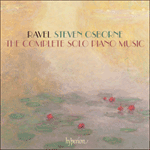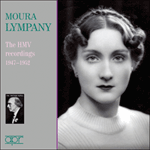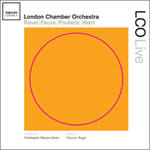Ravel's last set of piano pieces, the suite
Le tombeau de Couperin, acquired memorial significance only after his initial imagining of it as a
Suite française: when young friends of his began to die in the trenches, a nostalgic look at eighteenth-century French music in general assumed more personal references. There is therefore very little if anything here that is solemn, let alone lugubrious. After a digitally challenging ‘Prélude’, the ‘Fugue’ (Ravel’s only published example of the form) unfolds with a sense of placid purpose, enlivened by the countersubject’s descending triplet. The ‘Forlane’, written in the summer of 1914, was the first movement to be written, and Ravel prepared for it by transcribing the forlane from Couperin’s fourth
Concert royal, keeping the overall structure (ABACADA) but adorning it with some of his most acidic harmonies. After the ‘Rigaudon’, whose implacable outer sections enclose a dreamier central one, the last of his five ‘Menuets’ is a miracle of elegance and poise. The central musette brings with it a hint of the ‘Dies irae’ plainsong and builds into a powerful chromatic climax, before overlapping with insouciant skill beneath the return of the minuet. Ravel described the brilliant final ‘Toccata’ as ‘pure Saint-Saëns’—from him, a compliment to its excellent workmanship. Marguerite Long gave the first performance on 11 April 1919.
from notes by Roger Nichols © 2011
Dernier recueil de pièces pour piano de Ravel, la suite
Le tombeau de Couperin, a d’abord été conçue comme une
Suite française; ce n’est que plus tard qu’elle a pris une importance commémorative, lorsque de jeunes amis de Ravel ont commencé à mourir dans les tranchées, un regard nostalgique à la musique française du XVIIIe siècle en général prenant alors des références plus personnelles. Il y a donc ici très peu, peut-être même rien de solennel, à plus forte raison de lugubre. Après un «Prélude» difficile pour les doigts, la «Fugue» (seul et unique exemple de cette forme publié par Ravel) se déroule avec une détermination placide, animée par le triolet descendant du contre-sujet. La «Forlane», composée durant l’été 1914, est le premier mouvement à avoir été écrit et Ravel s’y est préparé en transcrivant la forlane du quatrième
Concert royal de Couperin, en conservant la structure d’ensemble (ABACADA), mais en la parant de certaines de ses harmonies les plus acides. Après le «Rigaudon», dont les sections externes implacables entourent une section centrale plus rêveuse, le dernier de ses cinq «Menuets» est un miracle d’élégance et d’aisance. La musette centrale apporte un soupçon de «Dies irae» et s’élève à un puissant sommet chromatique, avant d’empiéter avec une adresse insouciante sous le retour du menuet. Ravel a décrit la «Toccata» finale brillante comme «du pur Saint-Saëns»—un compliment de sa part à son excellent travail. Marguerite Long l’a créé le 11 avril 1919.
extrait des notes rédigées par Roger Nichols © 2011
Français: Marie-Stella Pâris
Ravels letzter Klavierzyklus, die Suite
Le tombeau de Couperin, wurde erst später zu einer Art Denkmal, nachdem er es zunächst als eine
Suite française betrachtet hatte: als junge Freunde von ihm in den Schützengräben starben, nahm der nostalgische Blick auf die französische Musik des 18. Jahrhunderts im Allgemeinen eine persönlichere Bedeutung an. Es findet sich daher kaum Ernstes, geschweige denn Düsteres darin. Nach einem technisch anspruchsvollen „Prélude“ entfaltet sich die „Fugue“ (Ravels einziges veröffentlichtes Werk in dieser Form) mit gelassener Zielgerichtetheit und wird durch die abwärts gerichtete Triole des Gegenthemas belebt. Die „Forlane“, die im Sommer 1914 entstand, war der erste Satz, den Ravel komponierte. Er bereitete sich darauf vor, indem der die Forlane aus Couperins viertem
Concert royal transkribierte. Er behielt die äußere Struktur (ABACADA) bei, verzierte sie jedoch mit besonders säuerlichen Harmonien. Nach dem „Rigaudon“, dessen unerbittliche Außenteile einen eher träumerischen Mittelteil umschließen, folgt das letzte seiner fünf „Menuets“, ein Wunder an Eleganz und Fassung. Die zentrale Musette bringt Anklänge an die „Dies irae“-Sequenz mit sich und bewegt sich auf einen großen chromatischen Höhepunkt zu, bevor sie sich mit unbekümmerter Geschicklichkeit mit der Wiederkehr des Menuett überschneidet. Ravel beschrieb die brillante Schluss-„Toccata“ als „puren Saint-Saëns“—von ihm war das ein Kompliment an die besondere Kunstfertigkeit, mit der das Stück gearbeitet war. Marguerite Long gab am 11. April 1919 die erste Aufführung des Werks.
aus dem Begleittext von Roger Nichols © 2011
Deutsch: Viola Scheffel


 Ravel: The Complete Solo Piano Music
Ravel: The Complete Solo Piano Music Moura Lympany - The HMV Recordings, 1947-1952
Moura Lympany - The HMV Recordings, 1947-1952 Ravel, Fauré & Poulenc: LCO Live
Ravel, Fauré & Poulenc: LCO Live
